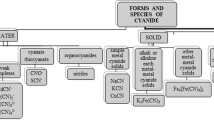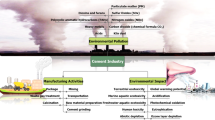Abstract
The risk of radioactive contamination of the environment is assessed using a comprehensive approach and examination of the questions, including analysis of the structure of the objects and the interaction between them, determination of the sources of the real and potential danger, development of scenarios for accidents and assessment of their probability, the radiation consequences of exposure of workers, the general public, and the environment during salvaging of the nuclear-powered fleet in the Russian northwest. A systematization of the risk is made and the distribution according to the degree of danger is determined.
Similar content being viewed by others
References
A. P. Vasil’ev, V. A. Mazokin, and V. A. Shishkin, “Problems of remediation of shore-based objects for storing spent nuclear fuel and radioactive wastes,” in: International Seminar on Scientific Problems and Unsolved Problems of Salvaging of Ships with Nuclear-Powered Systems and Ecological Remediation of the Servicing Infrastructure, Moscow, April 22–24, 2002, Moscow (2004), pp. 173–179.
Handbook on Monitoring Radioactive Contamination of the Environment and Internal Irradiation of the Crew of Ships with Nuclear Power Systems, Voenizdat, Moscow (1991).
Yu. V. Sivintsev, V. L. Vysotskii, and V. A. Danilyan, “Radioecological consequences of a radiation accident on a nuclear-powered submarine in Buhkta Chazhma,” At. Énerg., 76, No. 2, 158–160.
B. G. Pologikh, “Radiation loads on the region as a result of salvaging of nuclear-powered submarines and existing uncertainty in their estimates,” in: International Seminar on Scientific Problems and Unsolved Problems of Salvaging of Nuclear-Powered Ships and Ecological Reahbilitation of the Servicing Infrastructure, Moscow, April 22–24, 2002, Moscow (2004), pp. 340–357.
A. A. Sarkisov, V. L. Vysotskii, A. V. Denskevich, et al., “Results of the initial stage of radiation monitoring of the region of sinking of the nuclear-powered submarine K-159,” Izv. Ross. Akad. Nauk, É nergetika, No. 6, 102–108 (2004).
K. Sjobolm, A. Salo, J. Brewer, et al., “International Arctic Seas assessment project (IASAP), ” Sci. Total Environ., 237/238, 153–166 (1999).
A. I. Klemin, Engineering Probabilistic Computational Methods in the Design of Nuclear Reactors, Atomizdat, Moscow (1973).
O. B. Samoilov, Safety of Nuclear Power Systems, Énergoatomizdat, Moscow (1989).
Yu. V. Sivintsev, “Number of fissions during the reactivity accident in 1995 on the nuclear-powered submarine in Bukhta Chazhma,” At. Énerg., 91, No. 4, 297–298 (2003).
M. N. Ganul, N. L. Kuchin, I. V. Sergeev, et al., “On control concentrations of technogenic radionuclides in sea water,” Ékolog. Khim., No. 8(3), 197 (1999).
Taking Account of Emergency Situations Due to Human Activity During Selection of a Site for Nuclear Power Plants. Safety Manual, IAEA, Vienna (1983).
Yu. V. Sivintsev, S. M. Vakulovskii, A. P. Vasil’ev, et al., Radioecological Consequences of Sinking of Radioactive Wastes (White Book 2000), IzdAT, Moscow (2005).
Severity, Probability, and Risk of Accidents During Maritime Transport of Radioactive Materials, IAEA-TECDOC-1231 (2001).
M. Shumacher (ed.), Handbook of Marine Corrosion [Russian translation], Metallurgiya, Moscow (1983).
M. N. Ganul, N. L. Kuchin, and I. V. Sergeev, “Radiation consequences of the sinking of nuclear-technological servicing vessels,” At. Énerg., 85, No. 3, 283–287 (1998).
Modeling of Radioecological Impact of Radioactive Waste Dumping in the Arctic Seas, IAEA-TOCDOC-937, Vienna (1997).
S. Ali, H. Beanment, L. Dutton, et al., Evolution of the Radioecological Situation Around the Nuclear Reactors with Spent Fuel Which Have Been Scuttled in the Kara Sea, Report EUR-17634 (1997).
Coordinated Research and Environmental Surveillance Program Related to Sea Disposal of Radioactive Waste (CRESP). Final Report 1981–1995, OECD/NEA, Paris, France (1996).
I. A. Engovatov, V. P. Mashkovich, Yu. V. Orlov, et al., Radiation Safety During Decommissioning of Civilian and Military Reactor Systems, PAIMS, Moscow (1999).
D. V. Pankratov, V. S. Andreyanov, M. I. Bugreev, et al., “Problems of long-term and safe storage of off-loaded and nonoff-loaded spent nuclear fuel from nuclear powered submarines with liquid metal coolant,” in: International Seminar on Scientific Problems and Unsolved Problems of Salvaging Nuclear-Powered Ships and Ecological Rehabilitation of the Servicing Infrastructure, Moscow, April 22–24 (2002), Moscow (2004), pp. 271–282.
Radioactivity in Surface and Coastal Waters of the British Isles, 1992. Aquatic Environment Monitoring Report No. 48, MAFF, Directorate of Fisheries Research, Lowestoft (1993).
L. A. Pertsov, Biological Aspects of Radioactive Contamination of the Sea, Atomizdat, Moscow (1978).
International Scale of Nuclear Events (IMES). User Manual (IAEA-INES-2001), IAEA, Vienna (2001).
Author information
Authors and Affiliations
Additional information
__________
Translated from Atomnaya Énergiya, Vol. 101, No. 1, pp. 23–34, July, 2006.
Rights and permissions
About this article
Cite this article
Bogatov, S.A., Vysotskii, V.L., Sarkisov, A.A. et al. Analysis of the radioactive contamination of the environment due to decommissioned objects of the nuclear-powered fleet in northwestern Russia. At Energy 101, 485–493 (2006). https://doi.org/10.1007/s10512-006-0118-0
Issue Date:
DOI: https://doi.org/10.1007/s10512-006-0118-0




